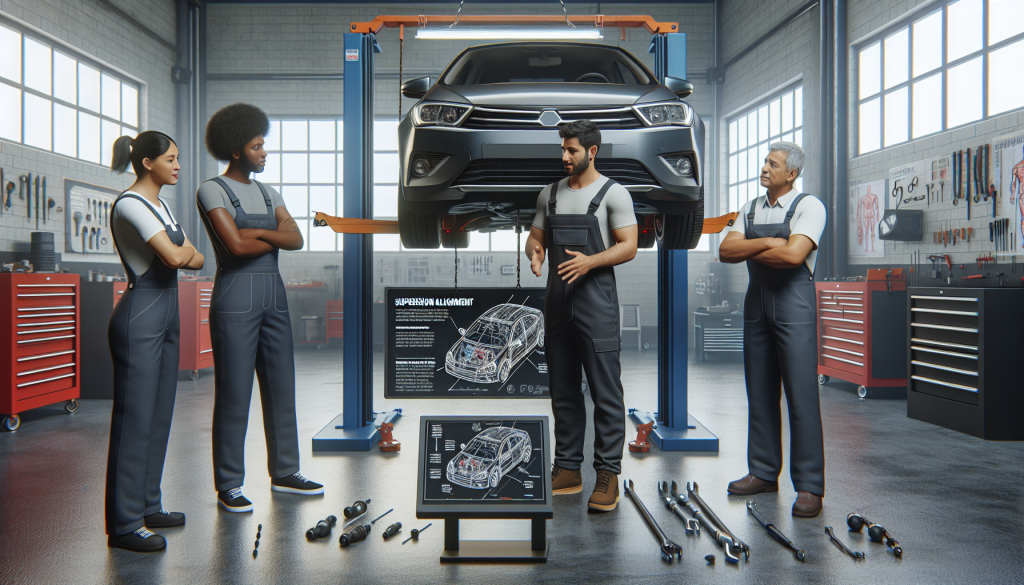Getting the Hang of Suspension Alignment
Why Suspension Alignment Matters
Keeping your car’s suspension aligned isn’t just about smooth rides—it’s about safety and saving money. Misalignment can chew up your tires unevenly, mess with your steering, and guzzle more gas. Regular checks keep everything in sync, making sure your car handles like a dream and stays safe on the road. Want to know more? Check out suspension alignment benefits.
The Magic of High-Precision Tools
When it comes to suspension alignment, having the right tools is a game-changer. High-precision gadgets like laser alignment systems, computerized machines, and digital angle gauges help mechanics get things just right. These tools make it easier to spot and fix alignment issues, speeding up the training process and ensuring top-notch performance. Curious about these tools? Dive into our guide on suspension alignment tools.
Tweaking Camber, Caster, and Toe
Suspension alignment is all about fine-tuning three main angles: camber, caster, and toe. Each one plays a role in how your car handles and how your tires wear out.
-
Camber: This is the tilt of your wheels when you look at them head-on. Negative camber (wheels tilt inward) helps with cornering but can wear out tires faster. Positive camber (wheels tilt outward) boosts straight-line stability. Getting the camber just right is key for balanced tire wear and smooth handling. Need the nitty-gritty? Check out adjusting camber in suspension.
-
Caster: This angle is about the steering axis when viewed from the side. Positive caster (top of the steering axis leans toward the driver) improves stability and cornering. Negative caster (top of the steering axis leans away) can mess with handling. Proper caster adjustment is crucial for straight-line tracking and responsive steering. For more details, visit adjusting caster in suspension.
-
Toe: This is the direction your wheels point when viewed from above. Toe-in (front of the wheels point inward) helps with straight-line stability. Toe-out (front of the wheels point outward) boosts cornering response. Getting the toe right ensures even tire wear and precise steering. Learn more about this in adjusting toe in suspension.
| Angle | Affects | Ideal Adjustment |
|---|---|---|
| Camber | Cornering, Tire Wear | Slightly Negative for Performance |
| Caster | Stability, Steering | Positive for Stability |
| Toe | Tire Wear, Steering Response | Slight Toe-In for Stability |
Mastering these angles during suspension alignment training means your car will handle better and your tires will last longer. For a step-by-step guide on the alignment process, check out suspension alignment process.
Boost Your Ride: Mastering Vehicle Alignment
Getting your car’s suspension right isn’t just about smooth rides—it’s about keeping your tires happy and your vehicle safe. Let’s break down how alignment training can make your car handle like a dream.
Keep an Eye on Your Alignment
Regular check-ups are a must. Catching alignment issues early means your tires wear evenly and your car drives straight. Aim to check your alignment every 6,000 miles or twice a year. Need a guide on setting up a routine? Check out our suspension system maintenance tips.
Test Drives After Tweaks
After tweaking your alignment, a test drive is crucial. Drive under different conditions to make sure everything’s spot on. Track how the car handles before and after adjustments to see the difference.
| Test Parameter | Before Alignment | After Alignment |
|---|---|---|
| Steering Wheel Position | Off-Center | Centered |
| Vehicle Pulling | Yes | No |
| Tire Wear Pattern | Uneven | Even |
Gear Up Your Technicians
Your techs need to be pros with the latest alignment gadgets. Training should cover all the new tricks for adjusting camber, caster, and toe. Certified and up-to-date technicians mean better service. Dive into more on this in our suspension alignment certification guide.
Teach Your Customers
Customers need to know why alignment matters. Misalignment can mess with tire life, fuel efficiency, and safety. Use brochures, workshops, or one-on-one chats to spread the word. For more on this, see our article on suspension alignment benefits.
Adjust for the Seasons
Seasons change, and so should your alignment checks. Temperature swings and road conditions can throw things off. Check your alignment with each season change and keep an eye on tire wear for early signs of trouble.
| Season | Alignment Check Needed |
|---|---|
| Winter | Yes |
| Spring | Yes |
| Summer | Yes |
| Fall | Yes |
Get more tips on seasonal adjustments in our articles on seasonal suspension alignment and tire wear monitoring.
By following these tips, your car will handle better, making every drive safer and more comfortable. For more on fixing suspension issues, visit our comprehensive guide.



